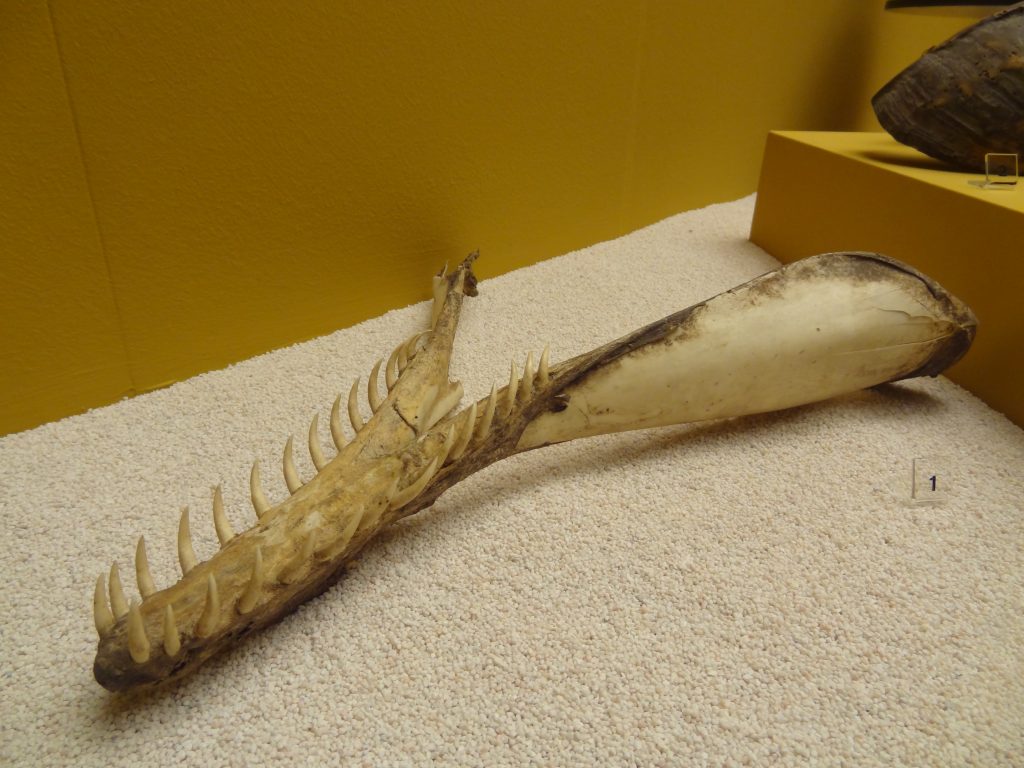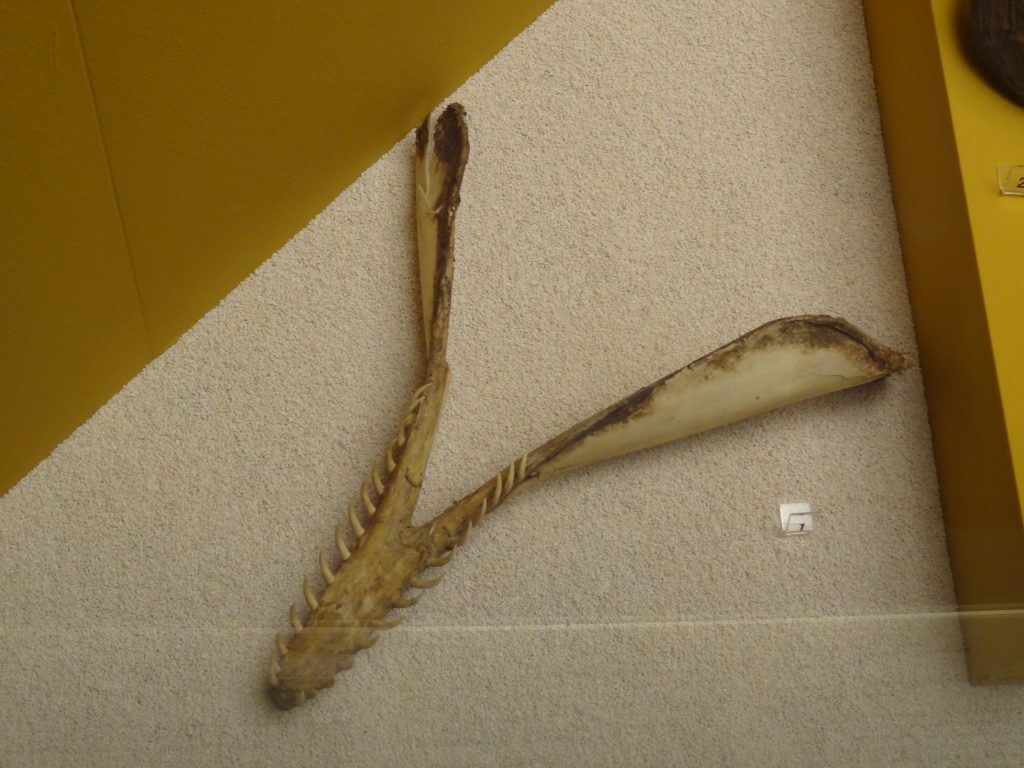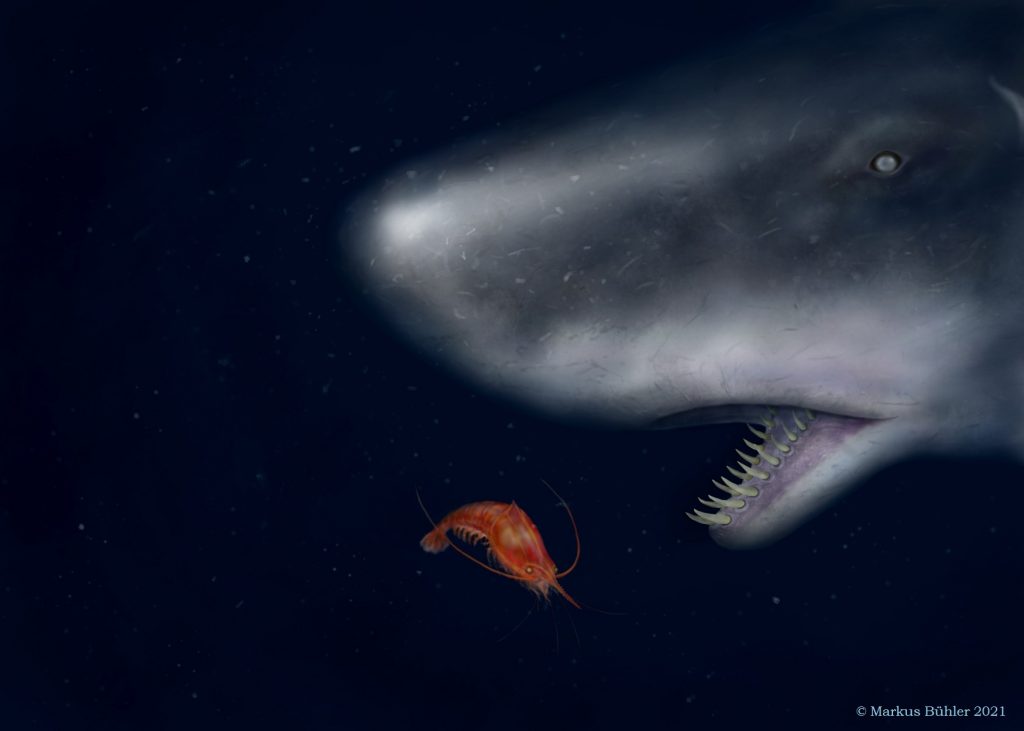The pygmy sperm whales and dwarf sperm whales are remarkable for a lot of reasons, for example for their extraordinary ability to release a dark substance from a gut pouch and hide within a cloud of their intestinal fluids. Not that long ago I have already covered and illustrated this bizarre behavior. But there is so much more to say about kogiids. I think it´s fair to say that they are among the weirdest extant whales. Today there are only two remaining species, the pygmy sperm whale Kogia breviceps and the dwarf sperm whale Kogia simus.

Their next living relative is the much more famous sperm whale Physeter macrocephalus. Physeter and Kogia share a number of anatomical and behavioral characters, like the prominent spermaceti organs which even extends their upper jaws. But there is a big difference. In Physeter the blowhole is located on the left side of the „nose“, close to the most anterior part of the giant spermaceti organ. In kogiids however the blowhole is still at the same position as in all other odontocetes, in the area above the eyes. It has only a very subtle and hardly recognizable lateral asymmetrical position and forms also no pronounced hump as the blowhole of Physeter. They also lack the weird array of multiple „humps“ which we find instead of a real dorsal fin in Physeter. The same applies to the lateral skin wrinkles of Physeter.
All in all the postcranial external anatomy of kogiids is as usual as possible. But at least their heads are absolutely weird. Their skulls are highly shortened and asymmetrical, with a big cranial basin for the anteriorly protruding spermaceti organ.
Their mouths are also highly unusual. The jaws are rather short and the opening of the mouth very small, nearly like an oval hole in the downside of the head. The mandibular teeth however are very long, thin and curved to the midline of the lower jaw. As a result of this weird tooth arrangement it seems that adult pygmy and dwarf sperm whales can’t fully close their mouths anymore, so they stand constantly partially open. In contrast to Physeter we find still erupted and functional upper teeth, but they are much lesser numerous and smaller in size than the mandibular teeth.

The combination of short jaws and a small opening of the mouth with very long thin teeth is quite unusual. In general we see the opposite condition, like comparably short jaws with small, blunt or missing teeth or elongated and narrow jaws with thin and long teeth. In contrast to Physeter we see also usually no battle scars from intraspecific fights so we can be quite sure that the bizarre comb-like teeth evolved for hunting and not fighting.

Pygmy and dwarf sperm whales feed mainly on small prey species which they usually hunt in depth of about 250-1.500 m. K. breviceps feeds mainly on small cephalopods whereas K. simus includes a bigger part of fish in its diet. Furthermore they also consume crustaceans like free swimming deep sea shrimps. I wanted to illustrate a hunting dwarf sperm whale in the deep sea, so I shamelessly reused my „pooping“ Kogia breviceps which I made for the blog article about the totally weird anti-predator behavior of kogiids. I had to paint much of the tail-part which was mainly blurred in the original illustration and without any detailing.
As prey species I chose a deep sea squid of the genus Taonius, which is known from the stomach contents of Kogia breviceps. This was a good chance to illustrate this rarely depicted cephalopod. This translucent squids show a very strong ontogenetic change with juveniles that have bizarre stalked eyes. The adults have highly reduced arms and still extremely bulging eyes. I also added a small swarm of hatchet fish for a bit more faunal diversity and to include a touch of bioluminescence.
But I also wanted another illustration which gives a better look on the incredible teeth of a pygmy sperm whale. Admittedly, I wanted to make it look a bit more intimidating for a more impressive effect, so I also added a reflection of the eye. In fact that´s how it can look like if marine mammals are illuminated by spotlights and filmed or photographed in dark water, so it´s not really that much imagination behind this. I used a screenshot from some deep sea footage of a sperm whale as main reference for the lights here.

I didn´t want just another cephalopod as prey item in this case, so I decided to illustrate a somewhat lesser common species from the known diet of Kogia breviceps. It´s Gnathophausia ingens, a species of lophogastrid crustacean. This bright-red mysids grow to pretty large sizes (up to about 35 cm) and inhabit depths of around 900-1,400 m. Crustaceans are not very common in the diets of cetaceans, but they can contribute a considerable (at least up to 15%) part to the diet of pygmy and dwarf sperm whales.
Not that long ago, there was also a case in which the considerably rotten corpse of a dwarf or pygmy sperm whale was found on the beach of a Philippine island Surigaro del Norte and lead to a lot of (nearly universally erronous) speculation about its identity. The paticularly weird cranial anatomy was surely one of the main reasons why so many people did not realize that this were in fact the remains of a cetacean, and not of a seal or seacow. I covered the case here.
References:
Beatson, E. (2007). The diet of pygmy sperm whales, Kogia breviceps, stranded in New Zealand: implications for conservation. Reviews in Fish Biology and Fisheries, 17(2–3), 295–303. https://doi.org/10.1007/s11160-007-9039-9
Staudinger, M. D., McAlarney, R. J., McLellan, W. A. & Ann Pabst, D. (2013). Foraging ecology and niche overlap in pygmy (Kogia breviceps) and dwarf (Kogia sima) sperm whales from waters of the U.S. mid-Atlantic coast. Marine Mammal Science, 30(2), 626–655. https://doi.org/10.1007/s11160-007-9039-9
